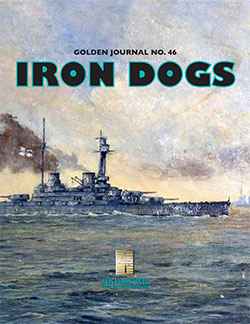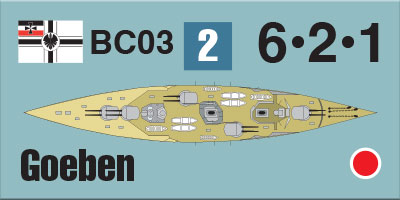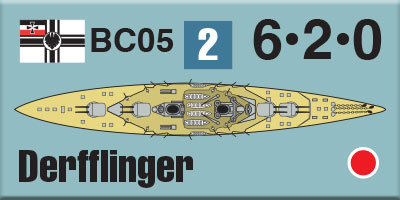Golden Journal No. 46: Iron Dogs
The Iron Dogs
by Mike Bennighof, Ph.D.
January 2022
 During the years before the First World War, the German High Seas Fleet worked out a doctrine that asked a great deal of its scouting forces. They would precede the battle fleet, seeking out the enemy and screening the battleships from the opposing scouting forces. Meanwhile, the cruisers would also be detached for lengthy overseas assignments; unlike the Royal Navy, the Germans did not build enough such ships to keep such assignments distinct. During the years before the First World War, the German High Seas Fleet worked out a doctrine that asked a great deal of its scouting forces. They would precede the battle fleet, seeking out the enemy and screening the battleships from the opposing scouting forces. Meanwhile, the cruisers would also be detached for lengthy overseas assignments; unlike the Royal Navy, the Germans did not build enough such ships to keep such assignments distinct.
The actual outbreak of war brought more burdens. The British Grand Fleet had overwhelming numerical superiority, and so the battle cruisers with their supposed speed advantage would be called upon to provide heavy support for light cruisers conduct commerce raids and minelaying missions, or to conduct provocative bombardments of the English coast.
Golden Journal No. 46: Iron Dogs is all about the battle cruisers that fought the Battle of Dogger Bank, German and British. To make play of the Dogger Bank scenarios in Jutland Second Edition and Jutland: Dogger Bank more fun, this volume of the Journal has giant-size pieces for the battle cruisers (and one big armored cruiser) that fought or could have fought at Dogger Bank. They’re the same size as the ones we used for Zeppelins, Land Cruisers and Rome at War, and fit (just barely) on the Great War at Sea Naval Tactical Map.
That helps show off the artwork, and the very sharp printing resolution of our die-cut and silky-smooth pieces.

Blücher
Authorized: 1906
Laid Down: 1907
Commissioned: 1909
The last armored cruiser ever built was also the best of them, but that doesn’t make Blücher a match for even the weakest of the British battle cruisers. She had a good turn of speed, and given the poor coal provided to the High Seas Fleet was not appreciably slower than the German battle cruisers at Dogger Bank in January 1915 – she was at the end of the German line not because she lagged behind, but because Scouting Forces commander Franz Hipper inexplicably put her there.
As the High Seas Fleet’s gunnery training ship and experimental testbed for new range-finders and other technology, Blücher could not be easily detached from the fleet for service in the Mediterranean or Far East, which might otherwise seem a more logical posting for an “odd number” cruiser. Thanks to that equipment and her crack gun crews, Blücher shot much better than the battle cruisers, and her smaller guns actually out-ranged the bigger weapons of her companions. She had older triple-expansion engines, which generated less speed than the turbines of the battle cruisers but were also far more reliable.
All of that couldn’t make up for her thinner armor. An obvious design flaw – the conveyor belts carrying shells from the magazines to the wing turrets – would lead to her destruction at Dogger Bank.

Von der Tann
Authorized: 1907
Laid Down: 1908
Commissioned: 1910
Germany’s first battlecruiser, von der Tann represented a very different philosophy than that behind the first British battle cruisers – unlike her rivals, the German ship would be expected to fight in the line of battle after the scouting phase of a fleet engagement had concluded. She had a battleship’s guns, but fewer of them, and the speed of a cruiser, at least in theory – poor-quality coal plagued all of the German battle cruisers throughout the war.
Von der Tann did not fight at Dogger Bank – the operation had been postponed, and the ship went into drydock for another of the interminable adjustments of her turbines. When the fleet commander changed his mind, von der Tann remained in the Imperial Dockyard though about 200 of her stokers and gunners went to sea aboard Blücher. She does appear in variant scenarios in our Jutland: Dogger Bank analysis book.

Moltke
Authorized: 1908
Laid Down: 1908
Commissioned: 1911
For the High Seas Fleet’s second battle cruiser, the Admiralty chose an enlarged version of von der Tann with ten rather than eight 280mm (11-inch) guns. Two ships would be built to the design, and the first, Moltke, steamed to North America and Russia in the years before the war.
At Dogger Bank, the British battle cruiser Tiger failed to fire at her assigned target, Moltke, allowing Moltke to fire undistracted at first Lion and then Tiger. She inflicted heavy damage on Lion, and scored a hit on Tiger that ignited the fuel stowage for her ships’ boats; German observers believed that Tiger had exploded and Lion had been sunk. Moltke suffered no damage at Dogger Bank.

Goeben
Authorized: 1909
Laid Down: 1909
Commissioned: 1912
Moltke’s sister ship Goeben did not fight at Dogger Bank; soon after completion she deployed to the Mediterranean where she remained at the outbreak of war – the German naval command did not recall her during the July Crisis, probably because she had been scheduled to undergo boiler repairs in the Austrian naval base at Pola.
While all of the German battle cruisers suffered from balky turbines and other mechanical defects, Goeben was a notable lemon. She had continual trouble with her boilers, and she could not be easily repaired at Constantinople, where she spent the remainder of the Great War. She engaged the Russian Black Sea Fleet several times, and survived the war to finally be scrapped in the early 1970’s.
Though she was not present for the Battle of Dogger Bank, we have several variant scenarios in our Dogger Bank analysis book where she does take part in the operation (having been recalled), so we included her in the Iron Dogs set.

Seydlitz
Authorized: 1910
Laid Down: 1911
Commissioned: 1913
The German flagship at the Battle of Dogger Bank, Seydlitz was built as an enlarged and improved version of Moltke despite several more modern designs having been offered by the Construction Department. She led the First Scouting Group (the German battle cruiser squadron) in all of the early-war operations.
At Dogger Bank she suffered three hits from 13.5-inch shells. The first and third did little damage, but the second ignited propellant charges in the aft-most turret’s handling room which sent flames into both aft turrets, instantly incinerating the gun crews and sending a massive spike of flame skyward. One hundred fifty-nine men died, and only the prompt action of Wilhelm Heidkamp kept the ship from exploding. Seydlitz commenced rapid fire in hopes of emptying her magazines, but the ship survived though she would be out of action until April.

Derfflinger
Authorized: 1911
Laid Down: 1912
Commissioned: 1914
Senior Naval Architect Hans Hüllman’s sketch for a new battle cruiser would become the best heavy ship ever built in Germany, and the best-designed heavy ship of the period. She marked a major change in German warship design, with very clean lines, clear arc of fire for her main armament (eight 305mm, or 12-inch, guns) good protection and good speed. All of that came at a price – she would be the most expensive warship built in Germany up to that time.
Derfflinger – the Iron Dog herself – commissioned in September 1914, and spent the next weeks working up and training her new crew. She joined the First Scouting Group in November 1914, in time to participate in the Scarborough Raid in December. Her second major operation would be the sortie that led to the Battle of Dogger Bank, where she scored the hits that put the British flagship Lion out of action, receiving one hit in return which only inflicted minor damage.
And those are the Germans of Iron Dogs. Next time, we look at the British.
The Golden Journal is only available to the Gold Club (that’s why we call it the Golden Journal).
Click here to join the Gold Club.
See your Gold Club Insider newsletter for ordering information.
Sign up for our newsletter right here. Your info will never be sold or transferred; we'll just use it to update you on new games and new offers.
Mike Bennighof is president of Avalanche Press and holds a doctorate in history from Emory University. A Fulbright Scholar and NASA Journalist in Space finalist, he has published a great many books, games and articles on historical subjects; people are saying that some of them are actually good.
He lives in Birmingham, Alabama with his wife, three children, and his Iron Dog, Leopold.
Want to keep Daily Content free of third-party ads? You can send us some love (and cash) through this link right here.
|
